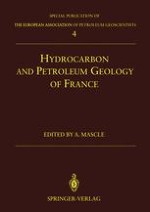1994 | OriginalPaper | Buchkapitel
Deformation of the Nord-Pas-de-Calais Carboniferous Coalfield (France) in the Variscan Frontal Tectonic Pattern
verfasst von : B. Le Gall
Erschienen in: Hydrocarbon and Petroleum Geology of France
Verlag: Springer Berlin Heidelberg
Enthalten in: Professional Book Archive
Aktivieren Sie unsere intelligente Suche, um passende Fachinhalte oder Patente zu finden.
Wählen Sie Textabschnitte aus um mit Künstlicher Intelligenz passenden Patente zu finden. powered by
Markieren Sie Textabschnitte, um KI-gestützt weitere passende Inhalte zu finden. powered by
Geometrical and kinematic evidence supplied by both reinterpreted mining and geophysical data emphasizes the significance of thrust tectonics in the overall structure of the Nord-Pas-de-Calais Carboniferous coalfield (NPC). On a balanced section passing through the Marchiennes antiform area, parallel to the regional shortening, the deformed NPC coalfield appears to be a northerly-thinning tectonic wedge, detached above a 25 km long gently S-dipping decollement that lies close to the Caledonian basement roof. To the S, it is overstepped by the Dinant Devonian unit along a major polyphase thrust contact referred to here as the Condroz-Midi thrust. The overall internal deformation of the NPC thrust wedge is related to a piggyback thrust sequence, strongly influenced by both stratigraphy and pre-existing basinal morphotectonic features, and involving, in its innermost part, a complex pile of dominantly Dinantian limestone thrust sheets. These latter are assumed to be underlain at depth by a basal hinterland-dipping duplex which may have been facilitated by easy slip along anhydritic layers. In fact, it gives rise farther N, beyond the evaporitic pinchout line, to a gentle N-verging imbricate fan causing decreasing displacements as far N as a blind tip line located close to the Evin frontal merging thrust.One of the most suitable aspects of our kinematic model is to relate the overall contrasted NPC surface structures to distinct mechanical processes acting during a single, but long-lived, thrust emplacement event. Hence, progressive rotation of hangingwall strata in frontal fault-propagation folds satisfactorily accounts for the downward-facing structures lying in the Epinoy and Barrois thrust sheets, whereas the poorly understood low-angle fault set transecting the Coal Measures is interpreted here in terms of extensional gravity structures developed on top of deeper Dinantian-cored thrust culminations migrating to the N.Lastly, the enigmatic Roucourt conglomeratic formation is likely to correspond to syntectonic deposits, supplied by active erosion of foreland-propagating thrust sheets, and which later unconformably overlap the entire thrust stack sequences.Quantitative estimates have also been attempted along the balanced Epinoy-Marchiennes transect, and they lead to a bulk horizontal shortening rate of 50 %, e. g., about 40 km, mainly achieved by thrusting, as along the Epinoy or the Barrois thrusts that induce northerly translations of 5 and 4 km, respectively. In our opinion, the concept of the Midi fault as a continuous and one-stage thrust contact is an oversimplication, which is better substituted for by a Condroz-Midi thrust concept that implies a multistage emplacement with an early large-scale overthrust later disrupted by a minor thrust (the socalled Midi fault of previous authors).On a regional scale, the entire NPC fold-thrust pattern seems to us to be indicative of a large-scale compressional impingement process including a mobile fold-thrust cover that migrates to the N and comes to mold and collide against a buried S-plunging asymmetric high (the Marchiennes antiform), acting at depth as a sort of steady frontal taper.
